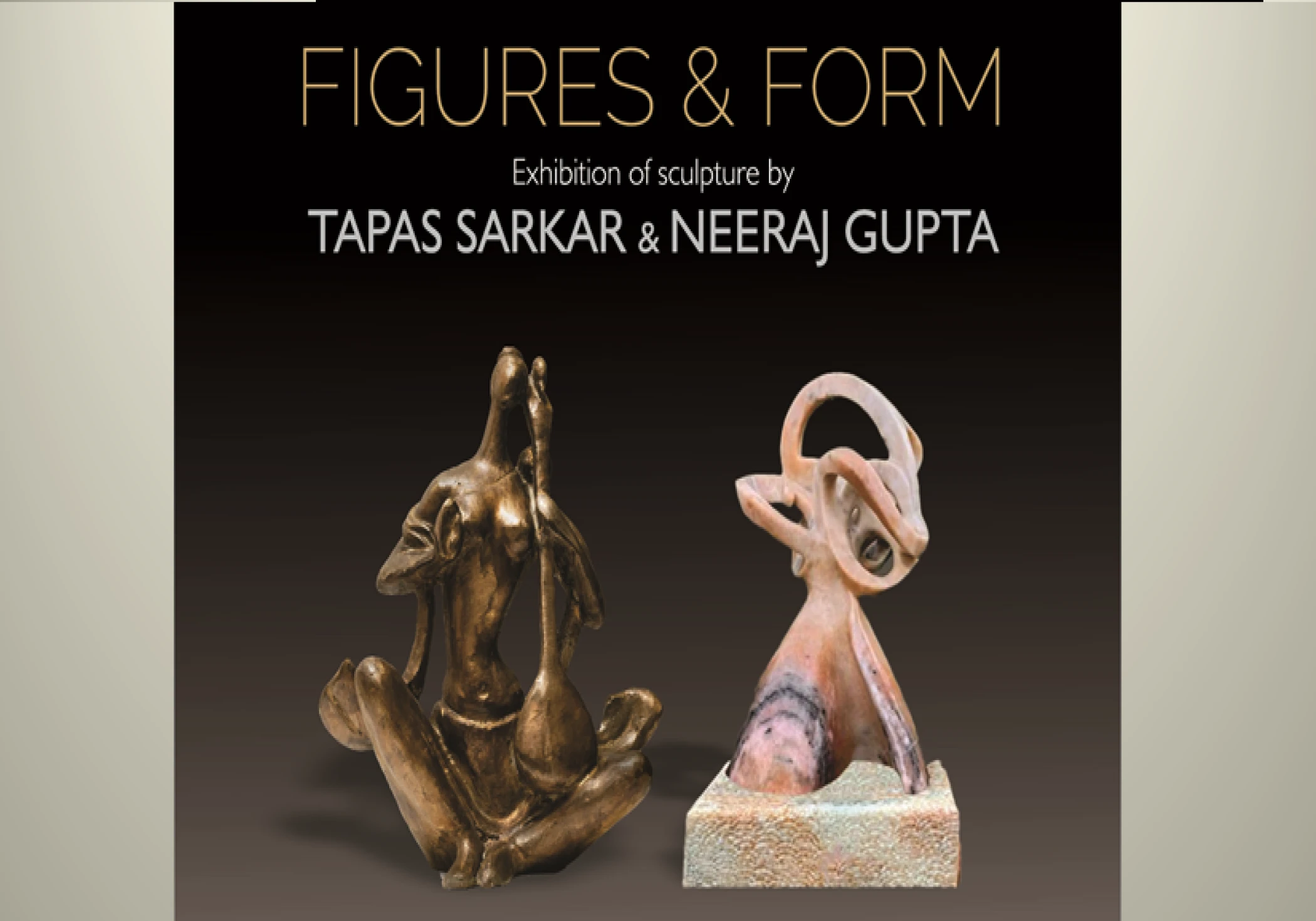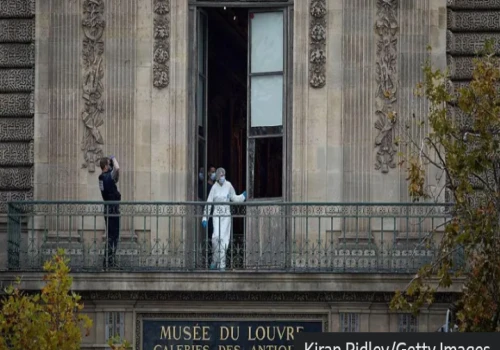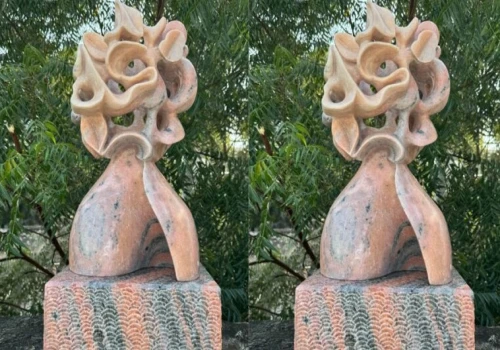
In the show titled ‘Figures and Forms, which will be held at Jehangir Art Gallery, May 13–19, 2025, the present is perpetually undermined by a future that will never fully materialize, partly because it is, in a sense, already here, and partly because it will only emerge under the condition of its own immediate negation. The sculptures of Tapas Sarkar and Neeraj Gupta are a genuine investigation of intimacy and sincerity in bronze and marble. This is an examination of the enthusiasm and skill of two sculptors that will transform the sculptural realm; each item is extraordinary and splendid and constitutes the most captivating and articulate representation of a sculptural cosmos. This discourse is an ongoing process distinct from previous notions of education, and it manifests as a crucial mechanism by which we acclimate to the changes affecting our lives. This highlights how a diverse array of imagery from the transforming landscape of postcolonial India contributed to the development of a visual language characterized by collage and citation, which subsequently served as a medium of cultural influence, shaping and negotiating concepts such as the sacred, the erotic, the political, the modern, and beyond.
The works of these two master sculptors encompass a considerable area with exceptional skill. Each individual, along with the practices and methodologies presented in this show, embodies the quintessence of their language, existence, achievements, and the manner in which their endeavors have illuminated an era and comprehension of a practice rooted in their own profound and timeless experiences, characterized by intricate patterns, elegance, precision, and contemporaneity.
About Tapas Sarkar
Tapas Sarkar is an Indian sculpture artist who was born in 1952 in West Bengal, India. He is a graduate of the Government College of Art and Craft, Kolkata. He worked as a modeler and head of the studio at the Indian Museum in Kolkata for many years before giving it up to pursue sculpting as a full-time profession.
The current display of Tapas Sarkar's bronzes inspires hope and spiritual grandeur. His latest sculptures combine mise en scène, memory, movement, and sketching. These components and combinatory rules are used to construct a work that matches its tropes' atmosphere, which gives it emotional resonance. His constants reveal his structural concerns and expressive growth. Tapas' sculptures often include human links and literary elements. This is a living organism, not just a form. Like his early sculptures, which are stark and unequivocal, his art is cryptic and scary, portraying an impenetrable realm or a vessel hiding the mind's workings. It combines meditative and aggressive elements in a complex way. The artist may generate unpredictability to inspire creativity in a society reaching equilibrium in its relationships with its surroundings.
He references metal, fiber, and wood sculptures with folk motifs, which depict and evolve a more finely carved style. The narrative develops, and his bronze works, such as “On the Bench,” “Way to the Dancing Ground,” and “Damsel,” emerge. He uses the story as a metaphor for atonement and joy in a tainted world. A mix of closeness and propriety that shows the sculptor's energy. When studying ideological mechanisms, the conceptual realm resembles a quartet: His pieces "Happy Family," "Togetherness," and "Sana With Her Pet" depict a static, frozen universe that blends intimacy with formality, demonstrating his unique style and linguistic prowess. He deliberately uses metal and grids to create sculptural environments. His increased understanding of materials and knowledge that concepts and materials are autonomous yet inseparable have led to more profound sculptures. New bronze sculptures at the exhibition continue to use minimalist light and heavy elements. This demonstrates his gradual and quick sculpture ideas.
As a sculptor, Neeraj Gupta has accepted the complexity and realism of using few materials to portray complex themes. He gives his new work a precisely made Markana marble or metal look. He blends poetry, sculpture, and technique to create strange visuals with poetic sensibility, wit, and sarcasm. He is enraptured by the unreal features of his stone picture. Through integrated materials, its surfaces paradoxically reveal a societal state rather than the artist's interiority. His conceptual framework resembles a quartet in the examination of ideological mechanisms, and he uses imaginative artistic license in the compositions to convey a more complete understanding of the site than a limited perspective could. This story explores architecture, historical tragedies, and the ruins of cities. The structure is a cosmic interpretation of human life; therefore, these aspects are not in place in the narrative but in the huge connections and feelings that accompany a story.
He tries to use parts of each language and cognition to develop a language that merges figures and deep space into a unified network of interconnecting shapes. Large sculptures, usually long-conceived but recently built, are democratic, bright, colorful, and recognized. We admire them gently. It is unknown how public sculpture may make the increasing urban landscape more compassionate and livable. This argument raises the question of whether Neeraj's marble sculptures' monumentality, stability, and permanence contradict his language's ephemerality. The language's complexities enable simultaneous, temporal, and multi-narrative statements. Time is more like a continuous progression than a series of incidents. That results in a constrained and hidden feeling of significance and importance rather than a blossoming of meaning through the metallic structure like this show.
About Neeraj Gupta
Neeraj Gupta (born 1969) is an artisan specializing in Makrana marble. His prominence as an expert in public art is highly recognized in India and beyond. His monumental sculptures at IIT Jammu and Kerala, at the tunnel entrance in front of Bharat Mandapam, and at various locations reflect an endeavor to harness elements of the language and concepts he has developed from a desire to fuse figures and expansive space into a cohesive network of interlocking forms.
His public art, like the massive installation at CCRT (Ministry of Culture) in 2021, uses value differential to create broad modulations and dramatic monochrome fields. In addition to warm and cold, the work includes expansion and contraction, which vary with poundage and weight regimens. His use of Makrana stone, bronzes, and metal, along with its articulation and gestural quality, captures the temporal movement of an intuitive subjective experience, culminating in a romantic apex through his participation in multiple exhibitions in India and abroad, including the Oak Bay Public Art Program in Vancouver, Canada; the Jerusalem Biennale in 2019; Nord Art in Germany in 2018; and the Santorini Biennale in Greece in 2016, among others.
Gupta's outdoor works show his approach, transcendental growth, and obsession with creation. He is an Indian art and aesthetics expert with deep insight. He judged the 2024 Republic Day Parade. He is creating a Delhi Public Art Master Plan. Modernist themes and subjects have been successfully combined with avant-garde style throughout his career.
Neeraj Gupta wrote a book on climate change that the Indian Environment Minister released on the eve of the Paris Climate Summit. His eight solo shows include those at IGI Airport and Jahangir Art Gallery, as well as the National Exhibition of Art at Lalit Kala Akademi. In 2005, he won the AIFACS 77th Annual Art Exhibition Best Sculptor Award. Any attempt to describe Neeraj's career will understate his talent. Many events highlight the beauty of artistic vision and expression as demonstrated through a variety of artworks. He receives revelations within the framework that defines and limits human importance. Neeraj has created avant-garde public art as grand and monumental as no one else, with experimental works that attract both the general public and connoisseurs because of the breadth of connections and emotions that follow a tale. Few modern sculptors can combine fun complexity with purposeful accessibility like Neeraj.
Chief Guests:
Mrs. Prachi Swaroop
Mr. Chandrashekhar Chore
Mr. Sundararaman Ramamurthy
Mr. Rajinders Patil
Curated by Nanak Ganguly
Venue:
Jehangir Art Gallery, M.G. Road, Mumbai
Dates: From 13th May 2025 to 19th May 2025
Timings: 11 AM to 7 PM





 Sculpture at National Gallery of Modern Art_500_x_350.webp)